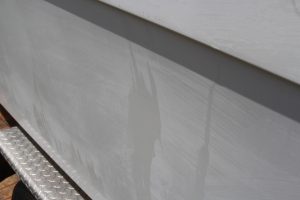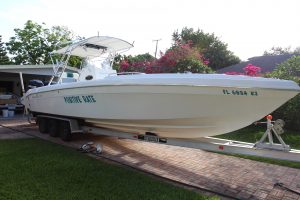Boat Year: 1997
Color: White
Issue: Dullness and inconsistency in the gel coat, removing competitive product
Result: Upon the removal of the competitive product and applying Glidecoat, the gel coat gloss meter readings increased from as low as 6 to upwards of 78 (brand new gel coat averages 85 on a gloss meter)
We were contacted by Marshal Skinner in Stuart, Florida, who had previously applied a competitive product to the hull of 32 foot Dakota. After one year, Marshal was experiencing cloudiness and fading caused by this product.
Before we could go through the steps necessary to apply Glidecoat Liquid Crystal on Marshal’s boat, we first had to remove the competitive product on the hull.

Removing competitive product. Note: swirl marks indicate that the competitive product is still on the surface, requiring wet sanding to remove. Click image to see enlarged picture
This proved to be a long and strenuous task. The first step to removing this product was using a stripping agent with a scotch brite pad. Working in small sections, we sprayed the stripping agent directly on the surface, then scrubbing the surface vigorously with the pad. After completing this step, there were still visible signs of the previous product on the hull. To completely remove this product, the use of heavy abrasion was required. We were forced to wet sand the hull with 1000 grit sandpaper. We only recommend wet sanding a boat in extreme circumstances because it will remove several layers of gel coat, making the surface extremely porous. After two full days of work, we were able to remove this competitive product, allowing us to begin the steps required to apply Glidecoat.
When dealing with older boats, most times an additional step of heavy duty compound is required to help restore the finish of the boat. After wet sanding the hull, we were left with a very dull and rough surface. With the use of a Makita rotary buffer, a wool pad, and heavy duty rubbing compound, we began to bring back the surface of the hull. Once completed, the next step was to use Glidecoat Nano Compound. This helped remove the swirl marks from the heavy-duty compound, creating a smooth uniform surface on the hull. The final buffing step was with Glidecoat Nano Polish, which restores the gloss and shine. These steps are very important to properly prep the surface before applying Glidecoat Liquid Crystal. Our product is designed to enhance and protect the current condition of the boat, so all surface imperfections must be removed during the compounding and polishing process.
The final step prior to applying Glidecoat Liquid Crystal is to decontaminate the surface with Glidecoat Surface Wipe. This is an alcohol based product that removes any leftover residue from the compound and polish. The surface must be clean in order to allow Glidecoat Liquid Crystal to fill in any pores and bond with the gel coat, providing amazing shine and protection.
Working in small 4 foot by 4 foot sections, we poured a dime size of Glidecoat Liquid Crystal onto the red application sponge. While applying medium pressure, we covered the entire section with our coating (the surface will appear to be sweating). Then with a clean microfiber towel, we buffed the coating into the surface immediately after applying, not allowing the coating to dry. It is important to use long, consistent strokes, to ensure the coating fills in the pours while also creating a smooth, uniform finish. Moving in small sections, we completed this step on the entire hull, as well as all flat fiberglass surface on the top side. Once we completely coated the boat once, we coated back the same areas, applying a second coat. The first coat provides a base filing the pores, while the second coat ensures all pores have been filled. In some cases, especially on older boats, a third coat may be required. If after two coats, the boat does not have an amazing shine, this will be an indication that an additional coat must be applied.
After three days of work, we were able to remove the competitive product from Marshal’s boat and apply Glidecoat Liquid Crystal. Taking the surface from gloss readings as low as 6, to upwards of 78 (brand new gel coat averages 85 on a gloss meter). Our coating will provide this boat with 12-18 months of protection. When the time comes for Marshal to have Glidecoat reapplied, our product will not have to be removed. We will repeat our steps; wash, compound, polish, surface wipe, and liquid crystal. We recommend the compound step while reapplying to older boats, to further improve the condition of the gel coat. When reapplying on newer boats, the compound step is not necessary during reapplication. Another benefit to Glidecoat is that each time it is reapplied, it continues to build up the gel coat, allowing for more protection and even further gloss and shine from previous applications.
If you are interested in becoming an Authorized Glidecoat Dealer, please connect with us. We are always available to answer any of your questions via (561) 290-0165 or dealer@glidecoat.com.

